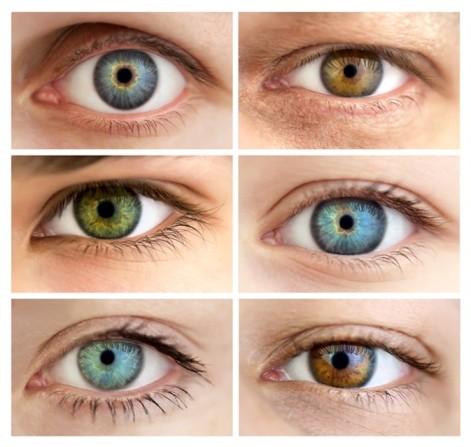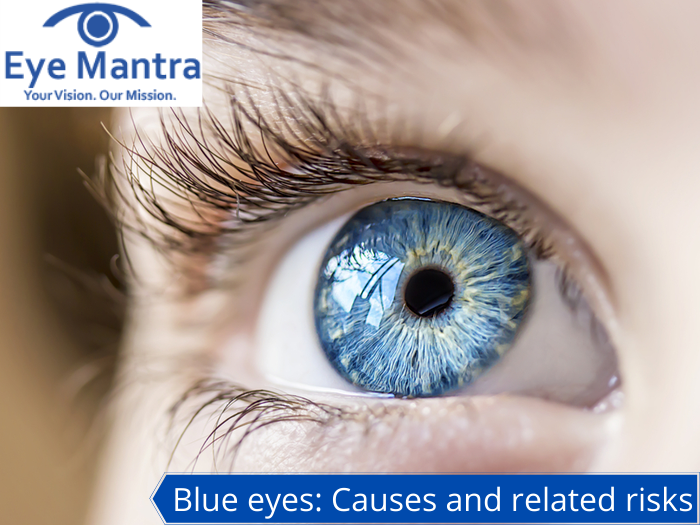Contents
How Eye Colour Is Determined?
Melanin Concentration
Eye colors are passed through genes from one generation to another. Melanin is a pigment that imparts different colors to different eyes. The difference in the eye colors amongst the population is due to the difference in the concentration of melanin content. The iris which is the colored part of the eye has two layers one in front and the other one at the back. People who have brown or black eyes have melanin present on the front and back layer of the iris through which when the light gets reflected causes the eye to look brown or black in color. When melanin is absent from the front layer of the iris then the light reflected from the eyes appears in blue color.

Genetic Information
The genetic information transmitted from the parents is transferred to the child which determines the content of melanin that would appear in the eyes of the child. The chromosomes inherited by the parents determine the eye color of the child. Chromosome number 15 plays a major role in determining the eye color of the child. The gene located in this chromosome provides instructions to the protein to produce melanin. When excess protein is produced melanin is released in excess quantity and gives a brown spectrum to the eyes and when it is produced in less quantity then it imparts blue or grey color.
Mutation
Brown eyes are present in the majority of the population in the world. This eye color causes more light to be absorbed and less light to be reflected which makes them naturally protected from the sun. Due to some genetic mutation some 6000 to 10,000 years ago one gene got turned off in the child having brown-eyed parents which caused the birth of the blue-eyed child. This mutated gene survived through many generations as people preferred to mate with blue-eyed people. Blue eyes are formed due to low levels of melanin content in the eyes this allows more light to get reflected back from the iris in the blue color spectrum which makes eye color appear blue. Blue coloured eyes are more prone to vision problems as eyes tend to be light sensitive.

Risks And Diseases Associated With Blue Eyes
Though blue eyes may seem very attractive they are associated with various risks.
Damage From UV Rays
Due to the presence of less quantity of melanin in the eye, the damage caused by the UV radiations and high energy blue light can be prevented. Melanin protects the eyes from these harmful rays but in the case of blue eyes risk of damage increases.
Light Sensitivity
There are increased chances of developing sensitivity towards the light which can damage the retinas in the eyes due to long exposure from the UV light.
- Increased exposure to the blue light from the screens increases the chances of damaging the eyes.
- Other risks
People with blue eyes have a high risk of getting eye cancer, diabetes, macular degeneration, and hearing loss. Though there are not many studies that provide the link to the diseases with eye color researchers are looking for a link between eye color and these diseases.
Eye Melanoma
Ophthalmologists tend to provide a prescription of wearing sunglasses to blue eyes people as they are at risk of developing eye cancers like eye melanoma. Eye melanoma is a rare disorder that occurs in people who have light skin color or light eye color. This type of cancer affects the area present between the retina and the white part of the eye. Melanoma generally affects the skin but they are also known to affect the eyes in a similar manner. When melanoma spreads from other body parts to the eyes then it is known as secondary eye cancer.
Macular Degeneration
There have been studies indicating that people who have type 1 diabetes generally have blue-colored eyes. Macular degeneration is an age-related eye disorder that gradually occurs in old age. In this, the vision becomes blurrier and more distorted. People who are old, fair skin, blonde hair and have blue eyes are at higher risk of developing macular degeneration.
Hearing Loss
There is a hypothesis that hearing loss is linked with blue eyes. Hearing loss is caused due to damage in the inner ear which uses melanin. Lack of melanin produced in the blue eyes can lead to a lack of production of melanin for the inner ear causing hearing loss in people. This theory is not yet proved and is only hypothesized based on the data available for hearing loss.
Endometriosis
Studies also suggest that the genes which control eye color are also responsible to cause endometriosis in women. Endometriosis or deep infiltrating endometriosis is caused due to growth of tissue outside the uterus which then invades the urinary tract. The advantage of having blue eyes is that you are less likely to develop vitiligo. It is a chronic skin disorder in which skin starts to lose the melanin content present in them which leads to the formation of white patches. Studies have shown that people who have blue eyes are at low risk of developing vitiligo.
Waardenburg Syndrome
Waardenburg syndrome is a disorder in which the skin, hair, and eyes start to lose pigment present in them. This causes the appearance of blue-colored rings in the brown eyes. This syndrome can cause changes in facial features as well as deafness in some people.
What Percent of World’s Population Have Blue Eyes?
They are genetically depleted, with only eight percent of the world’s population having blue eyes. While blue eyes are much lower than brown eyes worldwide, they are often found from nations near the Baltic in northern Europe.
While there are a ton of characters, models, and other celebs with blue eyes, they can make these coloured eyes look like ordinary goods (at least on television), not all people are lucky enough to brag about blue eyes. In fact, the most common eye colour in the world is brown, according to a World Atlas article. Specifically, 79 percent of the people have brown and chocolate-coloured eyes.
Although the odds of having blue eyes are much lower than getting brown eyes, blue is not a rare occurrence in all eye colours. In fact, it is actually the second most common eye colour out there, according to an article in the World Atlas, which is a little surprising given that eight to ten per cent is not the largest human base.
Grey eyes, red/violet eyes (usually in people with severe forms of albinism), and eyes with heterochromia (coloured eyes), all of which affect less than 1 percent of the world’s population.
Determining Eye Colour of Baby
It is possible to know the eye color of the child. If a child is born with blue eyes then it is not necessary that the blue color of the eye would remain in their later also as the body tends to produce more melanin in the later years of life which can change the eye color of the child. Also, there are 16 genes responsible for the development of eye color and it can also be influenced by the anatomic structure of the iris. It is not necessary that blue eye colored parents would develop blue eye color child. People with blue eyes should take proper care of their eyes as they are light sensitive.



